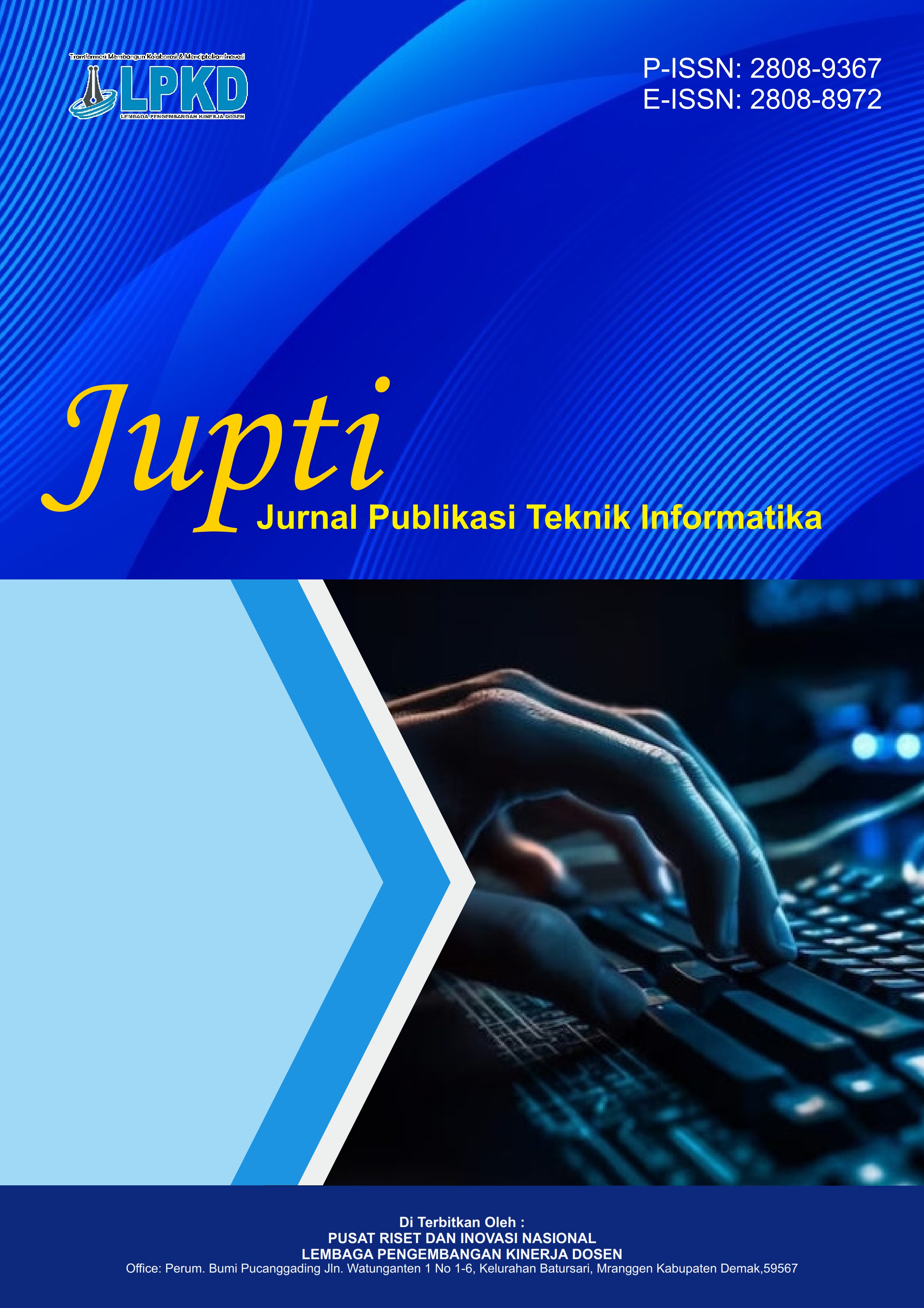Sistem Monitoring Kualitas Udara Perpustakaan Sekolah Menggunakan Algoritma Fuzzy Logic Berbasis Internet of things
DOI:
https://doi.org/10.55606/jupti.v4i3.5415Keywords:
Air Quality, Fuzzy Logic, Internet of Things, Monitoring, School Library.Abstract
In the modern era, air quality has become a significant environmental concern, especially in indoor public facilities such as school libraries where students and staff spend considerable time. Poor indoor air quality can negatively affect health, concentration, and overall comfort, highlighting the need for a reliable monitoring solution. This study proposes the design and implementation of an Internet of Things (IoT)-based air quality monitoring system integrated with a Fuzzy Logic algorithm. The system utilizes a DHT-11 sensor to measure temperature and humidity and an MQ-135 sensor to detect harmful gases. Data are transmitted in real time using the WEMOS D1 Mini microcontroller and processed through the Mamdani Fuzzy Logic method, producing intuitive linguistic outputs such as “good,” “moderate,” and “poor.” Testing results demonstrate that the system can effectively monitor temperature, humidity, and toxic gas concentrations simultaneously with acceptable accuracy. The air quality assessments generated are simple to interpret and useful for decision-making, enabling schools to maintain a healthy and comfortable learning environment. Moreover, the system provides a low-cost and scalable solution that can be further expanded to other public facilities. Its combination of Internet of Things and Fuzzy Logic ensures adaptability, accuracy, and practicality for small-scale environmental monitoring applications in libraries.
References
Anantama, A., Wantoro, A., Ahmad, I., Puspaningrum, A. S., Deviana, L. P., & Maharani, M. B. (2021). Implementasi metode fuzzy pada sistem sirkulasi udara berbasis Internet of Things. Kodifikasia: Jurnal Penelitian Islam, 15(1), 133–158.
Deniziak, S., Płaza, M., & Arcab, Ł. (2022). Approach for designing real-time IoT systems. Electronics, 11(24), 4120. https://doi.org/10.3390/electronics11244120
Dwipangga, A. A. K., Abdillah, M., Apriansyah, M. F., & Saputra, R. A. (2024). Implementasi logika fuzzy Mamdani untuk monitoring kualitas udara dalam ruangan. JATI (Jurnal Mahasiswa Teknik Informatika), 8(3), 3967–3974. https://doi.org/10.36040/jati.v8i3.9851
Fajriah, I. (2025). Pengaruh kualitas udara di tempat kerja terhadap kesehatan dan produktivitas pekerja. Termometer: Jurnal Ilmiah Ilmu Kesehatan dan Kedokteran, 3(1), 272–2853. https://doi.org/10.55606/termometer.v3i1.4869
Gu, X., Han, J., Shen, Q., & Angelov, P. P. (2023). Autonomous learning for fuzzy systems: A review. Artificial Intelligence Review, 56(5), 4311–4348. https://doi.org/10.1007/s10462-022-10355-6
Hassan, A. K., Saraya, M. S., Ali-Eldin, A. M. T., & Abdelsalam, M. M. (2024). Low-cost IoT air quality monitoring station using cloud platform and blockchain technology. Applied Sciences, 14(13), 5774. https://doi.org/10.3390/app14135774
Hidayati, Q., Zaini Rachman, F., & Rimbawan, M. A. S. (2020). Sistem monitoring kualitas udara berbasis fuzzy logic. ISAS Publishing, 6(1), 260–267.
International Organization for Standardization. (2020). International standard ISO/IEC competence of testing and calibration (pp. 1–38). https://www.iso.org/fr/standard/39883.html
Kencanasari, R. V., Surahman, U., Permana, A. Y., & Nugraha, H. D. (2020). Kondisi kualitas udara di dalam ruangan pemukiman non-kumuh Kota Bandung. Jurnal Arsitektur ZONASI, 3(3), 235–245. https://doi.org/10.17509/jaz.v3i3.28134
Muttaqin, R., Prayitno, W. S. W., Setyaningsih, N. E., & Nurbaiti, U. (2024). Rancang bangun sistem pemantauan kualitas udara berbasis IoT (Internet of Things) dengan sensor DHT11 dan sensor MQ135. Jurnal Pengelolaan Laboratorium Pendidikan, 6(2), 102–115. https://doi.org/10.14710/jplp.6.2.102-115
Narayana, T. L., Venkatesh, C., Kiran, A., J, C. B., Kumar, A., Khan, S. B., & Quasim, M. T. (2024). Advances in real time smart monitoring of environmental parameters using IoT and sensors. Heliyon, 10(7), e28195. https://doi.org/10.1016/j.heliyon.2024.e28195
Pop, M. D., Pescaru, D., & Micea, M. V. (2023). Mamdani vs. Takagi-Sugeno fuzzy inference systems in the calibration of continuous-time car-following models. Sensors, 23(21), 8791. https://doi.org/10.3390/s23218791
Putra, A. P., & Suwarno, J. (2022). Sistem monitoring suhu dan kelembaban untuk kandang reptil berbasis IoT dengan platform Blynk. Scientia Sacra: Jurnal Sains, 2(4). http://pijarpemikiran.com/index.php/Scientia
Putra, Y. P., Ishak, I., & Elfitriani, E. (2022). Rancang bangun papan informasi cuaca berbasis Arduino dan Visual Basic menggunakan teknik simplex. Jurnal Cyber Tech, 11(2), 1–9. http://ojs.trigunadharma.ac.id/index.php/jct/article/view/702
Shafa, A., & Sari, S. R. (2022). Penilaian kenyamanan termal pada ruang baca perpustakaan umum Kota Pekalongan. Review of Urbanism and Architectural Studies, 20(1), 23–32. https://doi.org/10.21776/ub.ruas.2022.020.01.3
Syahputri, N. I., Chiuloto, K., & Harahap, N. N. A. (2022). Analisa perbandingan membership function fuzzy Tsukamoto dalam menentukan dosen berprestasi. Blend Sains, 1(2), 134–142. https://doi.org/10.56211/blendsains.v1i2.134
Talarosha, B. (2017). Jendela dan dampaknya terhadap konsentrasi CO₂ di dalam ruang kelas: Kajian literatur. Jurnal Lingkungan Binaan Indonesia, 6(4), 188–195. https://doi.org/10.32315/jlbi.7.1.46
Vinola, F., & Rakhman, A. (2020). Sistem monitoring dan controlling suhu ruangan berbasis Internet of Things. Jurnal Teknik Elektro dan Komputer, 9(2), 117–126.
Yang, Z. (2017). Indoor air pollution and preventions in college libraries. IOP Conference Series: Earth and Environmental Science, 64(1), 012076. https://doi.org/10.1088/1755-1315/64/1/012076
Zafira, M. U., Ghozali, K., & Sabilla, I. A. (2022). Rancangan bangun prototype monitoring kualitas udara dalam ruangan. Jurnal Teknik ITS, 11(2), 91–96. https://doi.org/10.12962/j23373539.v11i2.86341
Downloads
Published
How to Cite
Issue
Section
License
Copyright (c) 2025 Jurnal Publikasi Teknik Informatika

This work is licensed under a Creative Commons Attribution-ShareAlike 4.0 International License.








